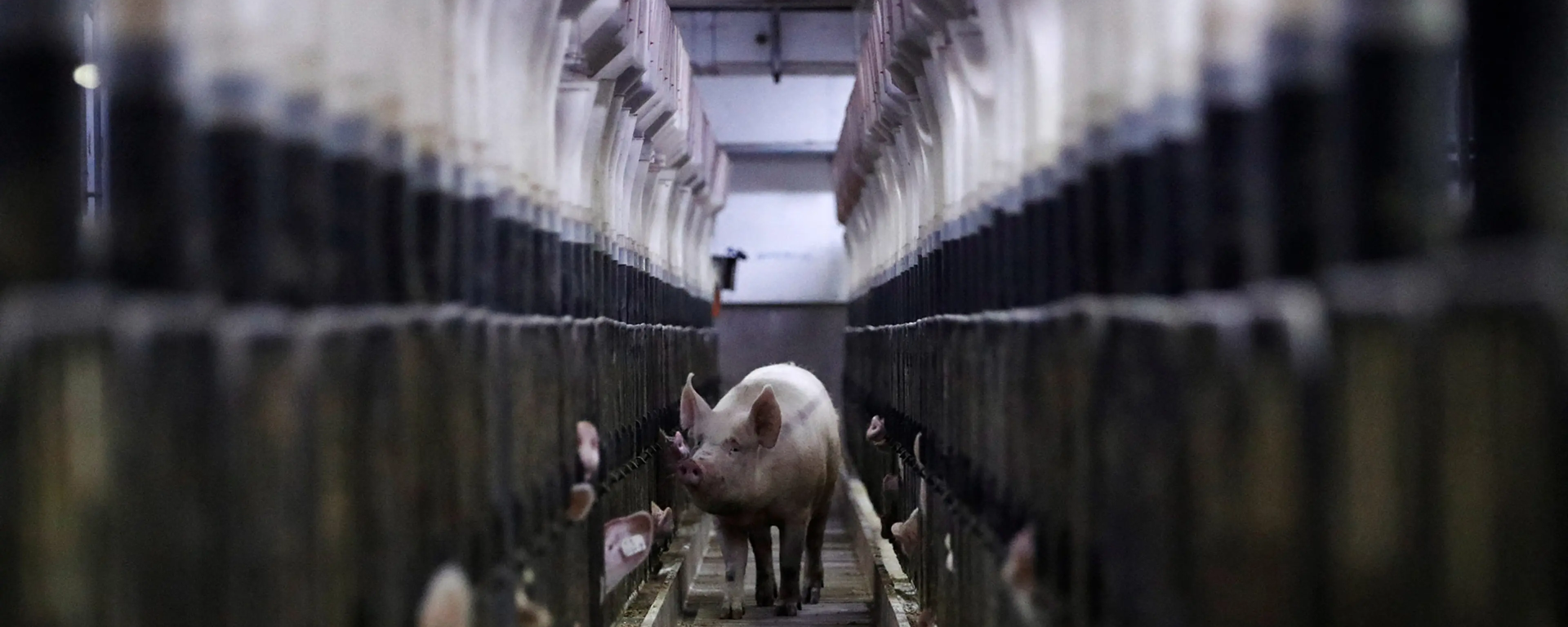
At a Best Genetics Group pig-breeding farm in Chifeng, China; 27 February 2022. Photo courtesy Tingshu Wang/Reuters
AI could lead to new ways for people to abuse animals for financial gain. That’s why we need strong ethical guidelines
Virginie Simoneau-Gilbert is a DPhil candidate in philosophy at the University of Oxford with the support of a Rhodes scholarship and a doctoral scholarship from the Fonds de recherche du Québec Société et Culture. Her research interests include animal ethics, practical ethics, moral theory, and philosophy of emotion.
Jonathan Birch is a professor of philosophy at the London School of Economics and Political Science, and principal investigator on the Foundations of Animal Sentience project. He is the author of The Philosophy of Social Evolution (2017) and The Edge of Sentience (forthcoming, 2024).
Imagine a long black shipping container, packed with living animals. You tip in some human food waste and walk away. AI does the rest, controlling feeding and growth ‘so the farmer does not have to’, as the company blurb puts it. What are these animals inside – your animals? It’s not important. You don’t need to know anything about them or have any experience handling them. If problems arise, engineers can troubleshoot them remotely. And when it’s time for ‘harvesting’, no need for a slaughterhouse: AI handles that too. The animals live and die in a literal black box, only leaving as a ready-made product.
The future of farming? No, the present: this is a description of the ‘X1’ insect farm developed by the UK startup Better Origin. Of course, the farming of large animals, like pigs, chickens and fishes, is usually a lot less high-tech than this. Farms are not yet fully automated. But with the technology advancing rapidly, trends towards increasing automation are clear to see.
How much do we want AI to be involved in farming? The time for that conversation is now, before these trends are irreversibly locked in. Now is the time to set reasonable ethical limits.
What is AI used for now? Several different applications are starting to gain traction. All share the same basic vision of placing AI at the centre of a control network, using it to intelligently manage the data that flows in from an array of automated sensors. The sensors may be placed on various animal body parts and track body temperature, respiration, heart rate, sound, even rectal temperature and bowel movements. Other sensors monitor activities such as grazing, ruminating, feeding and drinking, picking up signs of lameness or aggression. Smart ear-tags allow farmers to recognise animals individually and are sold on the promise of more personalised care. AI can crunch the readings, images and sounds to diagnose health problems and predict whether they are likely to get better or worse. Meanwhile, other AI products monitor and control environmental factors, such as temperature and carbon dioxide levels. These tools aim to predict and prevent disease outbreaks, with a special focus on dangerous diseases like African swine fever. GPS trackers put on animals and satellite images provide real-time location information. This information, when handled by AI, allows farmers to predict their cows’ grazing behaviour, manage their pastures, and maintain soil vitality.
Put like this, these new developments may sound like great news for animal welfare. Indeed, we want to present the case for AI optimism as charitably as we can – before turning to the problems. The optimists’ argument is simple. Farmed animals are sentient beings, capable of feeling pleasure and pain. Their wellbeing matters, and it can be positively or negatively impacted by the way we treat them. Yet traditional, AI-unassisted farming systematically misses many welfare problems because human detection is not vigilant enough. AI takes vigilance to the next level, helping farmers give their animals good lives. In the dairy and beef industry, automated sensors could spare cattle from undergoing intrusive and unpleasant interventions at the hands of humans, like body temperature measurement. Real-time location systems could allow them to graze and explore their environment more freely instead of living at the end of a tether. In the poultry and pork industries, AI could help ensure that the average chicken or pig is well fed and has enough water. Individual health monitoring tools could also enable farmers to take care of sick or injured animals quickly or euthanise those in pain. Environmental sensors designed to predict disease outbreaks would indirectly prevent the suffering and early death of many animals. And all this can be sold to farmers as an investment that is economically beneficial, since high levels of death and disease are bad for business (think of how a disease epidemic can rip through a flock of birds or a herd of pigs, destroying profit margins along with lives). Defenders of animal welfare should support investment in agricultural AI, say the optimists…
more…
https://aeon.co/essays/how-to-reduce-the-ethical-dangers-of-ai-assisted-farming



